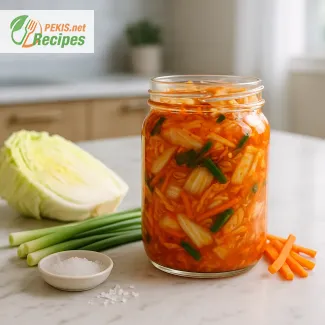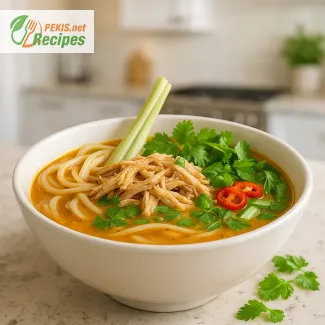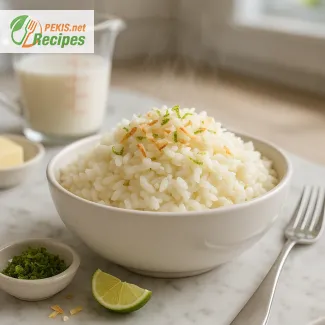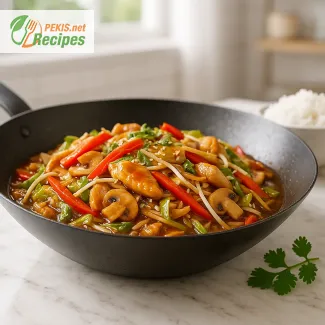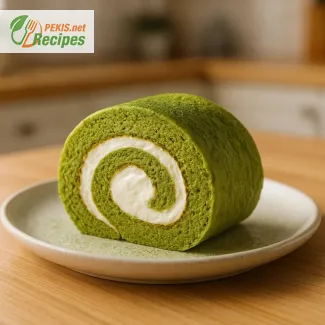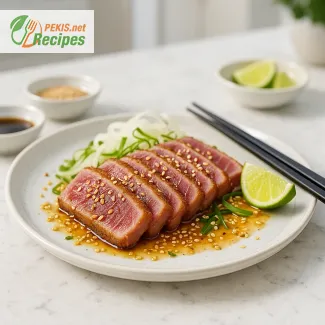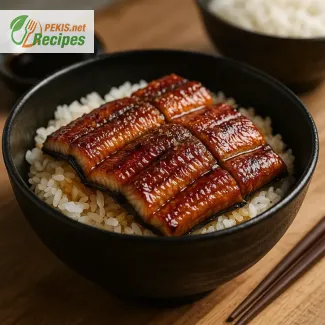
Master the Art of Japanese Grilled Eel at Home
Discover the secrets behind preparing traditional unagi from scratch
In Japanese cuisine, few dishes captivate the senses quite like unagi, the delicate yet richly flavored freshwater eel that's glazed in a sweet-savory tare sauce and grilled to perfection. Known for its deep umami notes and melt-in-your-mouth texture, unagi is more than a meal—it's a cultural experience. This recipe allows you to recreate that authentic Japanese grilled eel in your own kitchen with precision and respect for the tradition it represents.
What is Unagi and Why It Matters in Japanese Cuisine
Unagi (うなぎ) refers to freshwater eel and has long held a place of honor in Japanese culinary tradition. Most commonly enjoyed as unagi kabayaki, where the eel is filleted, butterflied, skewered, and grilled with a lacquer of thickened tare sauce, it's a staple in high-end restaurants and home kitchens alike. Traditionally eaten during Doyo no Ushi no Hi (the midsummer day of the ox), unagi is believed to restore stamina and vitality.
Beyond its seasonal association, unagi has become synonymous with Japanese fine dining, and its preparation is considered a marker of skill among chefs. The grilling technique and precise balance of the sauce are crucial to its signature taste.
Sourcing the Right Eel for Your Unagi Recipe
One of the most important steps in making unagi at home is selecting the right eel. Look for freshwater eel (Anguilla japonica or Anguilla rostrata) rather than saltwater varieties. If fresh eel isn’t available, frozen unagi fillets can serve as a reliable alternative—just ensure they’re unseasoned and skin-on. Always prioritize quality and origin, as eel farming and sustainability are major concerns in today's food landscape.
Tare Sauce: The Heart of Authentic Grilled Unagi
A defining feature of unagi is the tare sauce, a glossy blend of soy sauce, mirin, sugar, and sake. This sauce not only caramelizes beautifully during grilling but also penetrates the tender eel flesh, delivering layers of complexity with each bite. The sauce is typically simmered down until slightly thickened and then brushed on repeatedly during the grilling process.
Each family and chef may have their own version, often aged over time, resulting in a deeply personal flavor profile. In this recipe, we focus on creating a balanced tare that enhances the eel’s natural richness without overpowering it.
Traditional Grilling Techniques for Unagi
The hallmark of great Japanese grilled eel lies in the method of cooking. Unagi is often grilled over charcoal for a subtle smoky finish. The process involves an initial steaming or broiling step to remove excess fat, followed by repeated grilling and basting sessions to achieve that characteristic glaze.
If you don't have access to a charcoal grill, a broiler or stovetop grill pan can still yield excellent results. The key is to manage the heat carefully and apply the tare in layers, allowing it to thicken and create a lacquered finish on the eel’s surface.
Serving Suggestions and Regional Variations
Unagi is most commonly served over a bed of steamed rice as unadon or in a stacked lacquer box as unaju, accompanied by sansho pepper and pickles. Regional styles differ: in Kanto (eastern Japan), the eel is steamed before grilling, producing a more tender texture, while in Kansai (western Japan), it’s grilled directly, resulting in a crispier bite.
Pairing unagi with sides such as miso soup, sunomono (vinegared cucumber salad), or tamagoyaki (Japanese omelette) adds balance to the richness of the dish. A bowl of short-grain Japanese rice is essential to absorb the tare and complete the meal.
The Cultural Significance and Ritual of Eating Unagi
Eating unagi is not just about flavor—it's about ritual and season. In Japan, its consumption is tied to summer energy renewal, and it's seen as a comforting, soul-satisfying food that brings both physical and emotional warmth.
Recreating this dish at home allows you to connect with that tradition, bringing a piece of Japanese culinary heritage to your table. Whether you’re exploring unagi for the first time or refining your home-cooked Japanese repertoire, this recipe guides you step by step toward restaurant-quality results.
- Prepare the tare sauce:
In a small saucepan, combine soy sauce (120 ml), mirin (100 ml), sake (100 ml), and sugar (50 g). Bring to a gentle boil over medium heat, then reduce the heat and let it simmer for 15–20 minutes, or until it thickens slightly into a glaze. Stir occasionally to prevent burning. Set aside. - Clean and prep the eel:
If using fresh eel, ensure it's cleaned and filleted properly. Pat dry with paper towels. If using frozen eel, thaw it completely and gently pat dry. - Optional steaming (Kanto style):
Place the eel fillets skin-side down on a steamer rack and steam for 5 minutes over medium heat. This step makes the eel more tender and removes excess fat. (Skip this step if you prefer the crispier Kansai style.) - Grill the eel (first round):
Preheat your grill or grill pan over medium heat. Lightly grease it with vegetable oil (15 ml). Place the eel fillets skin-side down and grill for about 3 minutes. Flip and grill the other side for 2 minutes. Do not brush sauce yet. - Glazing and grilling (second round):
Begin brushing the tare sauce onto both sides of the eel and return to the grill. Grill for 2 minutes on each side, brushing sauce 2–3 times during this step. Repeat until the surface is glossy and lightly caramelized. - Prepare the rice base:
Scoop freshly cooked Japanese short-grain rice (800 g) into serving bowls or lacquered boxes. Lightly press down to create a flat bed. - Assemble the dish:
Slice each grilled eel fillet into bite-sized portions and place them neatly over the rice. Brush once more with leftover tare sauce for extra shine and flavor. - Garnish and serve:
Optionally sprinkle with sansho pepper (2 g) for a light citrusy kick. Serve immediately while warm.
Elevating Homemade Unagi: Smart Tweaks for a Next-Level Experience
Refine, balance, and personalize your Japanese grilled eel
Unagi is a celebrated delicacy with centuries of culinary tradition behind it, but that doesn’t mean it can’t be thoughtfully adapted to enhance the experience when made at home. From customizing the tare sauce to exploring different textures and cooking methods, there are many subtle ways to elevate this beloved dish without losing its authenticity. With the right tweaks, even a simple home-cooked version can rival the best unagi bowls served in Tokyo’s finest restaurants.
Upgrade your tare sauce for more depth
The tare sauce is the soul of Japanese grilled eel, and adjusting its composition can dramatically shift the final flavor. For a deeper umami profile, try adding a splash of aged soy sauce or a few drops of mushroom extract to the base. Replacing part of the sugar with Japanese black sugar (kokuto) lends a more complex sweetness. A small piece of dried kombu, simmered briefly in the sauce, introduces an earthy ocean note that pairs naturally with eel.
For those who enjoy a spicy finish, stirring in a touch of yuzu kosho or grated ginger can lift the glaze and give the dish a refreshing balance. Even subtle changes to the simmer time will affect the viscosity and caramelization of the sauce—longer simmering produces a richer, more lacquered glaze, while shorter times allow the eel’s natural flavor to shine.
Texture matters: steaming vs. direct grilling
Traditional unagi preparation differs significantly between eastern and western Japan. If you prefer a more tender and delicate texture, incorporate a light steaming step before grilling. This helps soften the eel and remove excess fat. However, if you favor a smokier, more robust flavor, skip the steaming and grill directly over high heat. You can experiment with binchotan charcoal to impart a subtle smokiness that’s hard to replicate with standard grills.
For crispier skin, allow the eel to rest between each grilling and glazing round. This pause helps the tare set and prevents the eel from becoming too soft or soggy.
Health-conscious adaptations that still honor tradition
Eel is naturally rich in omega-3 fatty acids, but the traditional tare can be high in sugar and sodium. To make your homemade unagi a little healthier, use low-sodium soy sauce and reduce the sugar slightly, relying more on mirin and sake for sweetness and complexity.
If you’re avoiding eel altogether, substitute with eggplant slices brushed with tare and grilled until tender. This is a popular vegetarian unagi variation in Japan and captures the essence of the dish without compromising on presentation or flavor. For a leaner protein, try grilled mackerel or chicken thighs with the same glaze.
Mistakes to avoid when making unagi
A common issue is overcooking the eel, which causes it to dry out and lose its buttery texture. To avoid this, monitor heat carefully and don’t skip resting periods between grilling and glazing. Another mistake is applying the tare too early or in thick layers, leading to burnt sugar on the surface before the eel is cooked through. Always glaze in thin coats and grill gently for even browning.
Rice also plays a crucial role—using the wrong grain or undercooking it can disrupt the balance of the dish. Stick to high-quality Japanese short-grain rice and cook it slightly firm so it can absorb the tare without turning mushy.
How homemade unagi beats store-bought versions
Making unagi at home allows you to control every element—from the quality of the eel and balance of the sauce to the final presentation. Store-bought or pre-marinated eel often contains preservatives, excessive sugar, or artificial flavors that mask the natural richness of the fish. At home, you can opt for sustainably sourced eel, reduce additives, and achieve a fresher, more authentic taste.
You also have the freedom to personalize the recipe to match your preferences—sweeter, spicier, or cleaner versions that aren’t possible with ready-made options. And perhaps most importantly, preparing unagi from scratch transforms the meal into a cultural experience, making it more meaningful and satisfying.
Additional enhancements for flavor and presentation
- Garnish with shredded nori or toasted sesame seeds for texture and aroma
- Add a soft-boiled egg marinated in soy and mirin as a protein-rich topping
- Serve alongside pickled daikon or cucumber sunomono to cut the richness
- Sprinkle citrusy sansho pepper just before serving for a traditional finishing touch
- Replace part of the rice with cauliflower rice for a lower-carb variation without losing the tare-soaked base
These simple upgrades not only enhance the taste and texture of grilled unagi but also allow you to tailor the dish to your lifestyle and dietary goals, while maintaining its deeply rooted Japanese identity.
Allergens present in the recipe:
- Soy (from soy sauce)
- Fish (eel)
- Gluten (from regular soy sauce)
Tips for allergen and gluten replacement:
- Use gluten-free soy sauce or tamari to eliminate gluten.
- For soy allergies, replace soy sauce with coconut aminos.
- Replace eel with grilled eggplant or shiitake mushrooms for a vegetarian alternative.
Vitamins and minerals per serving (approximate):
- Vitamin A: 280 IU – Supports eye health and immune system
- Vitamin B12: 6.2 µg – Essential for red blood cell formation and nerve health
- Vitamin D: 320 IU – Helps calcium absorption and bone strength
- Iron: 3.4 mg – Prevents fatigue and supports oxygen transport
- Magnesium: 42 mg – Aids muscle function and energy production
- Phosphorus: 210 mg – Important for healthy bones and teeth
- Potassium: 380 mg – Regulates fluid balance and heart function
- Zinc: 2.1 mg – Boosts immune response and skin repair
Antioxidants per serving (approximate):
- Vitamin E: 2.3 mg – Protects cells from oxidative stress
- Selenium: 21 µg – Supports thyroid function and immune defense
- Flavonoids (from tare sauce): Moderate – Help reduce inflammation
- Omega-3 fatty acids (from eel): 0.9 g – Support cardiovascular and brain health
